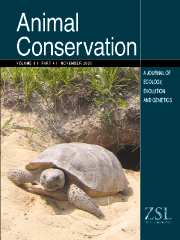Crossref Citations
This article has been cited by the following publications. This list is generated based on data provided by
Crossref.
Hedrick, Philip W.
Parker, Karen M.
Gutiérrez-Espeleta, Gustavo A.
Rattink, Annemieke
and
Lievers, Karin
2000.
MAJOR HISTOCOMPATIBILITY COMPLEX VARIATION IN THE ARABIAN ORYX.
Evolution,
Vol. 54,
Issue. 6,
p.
2145.
Marshall, T. C.
and
Spalton, J. A.
2000.
Simultaneous inbreeding and outbreeding depression in reintroduced Arabian oryx.
Animal Conservation,
Vol. 3,
Issue. 3,
p.
241.
Hedrick, Philip W.
Parker, Karen M.
Gutiérrez-Espeleta, Gustavo A.
Rattink, Annemieke
and
Lievers, Karin
2000.
MAJOR HISTOCOMPATIBILITY COMPLEX VARIATION IN THE ARABIAN ORYX.
Evolution,
Vol. 54,
Issue. 6,
p.
2145.
Holt, William V.
Pickard, Amanda R.
Rodger, John C.
and
Wildt, David E.
2002.
Reproductive Science and Integrated Conservation.
p.
21.
Hedrick, Philip
2002.
Reproductive Science and Integrated Conservation.
p.
97.
Marshall, T. C.
Coltman, D.W.
Pemberton, J.M.
Slate, J.
Spalton, J. A.
Guinness, F. E.
Smith, J. A.
Pilkington, J. G.
and
Clutton–Brock, T. H.
2002.
Estimating the prevalence of inbreeding from incomplete pedigrees.
Proceedings of the Royal Society of London. Series B: Biological Sciences,
Vol. 269,
Issue. 1500,
p.
1533.
Mésochina, Pascal
Bedin, Eric
and
Ostrowski, Stéphane
2003.
Reintroducing antelopes into arid areas: lessons learnt from the oryx in Saudi Arabia
.
Comptes Rendus. Biologies,
Vol. 326,
Issue. S1,
p.
158.
RYDER, O. A.
2003.
Genetic studies in zoological parks and their application to conservation: past, present and future.
International Zoo Yearbook,
Vol. 38,
Issue. 1,
p.
102.
Boakes, E H
Wang, J
and
Amos, W
2007.
An investigation of inbreeding depression and purging in captive pedigreed populations.
Heredity,
Vol. 98,
Issue. 3,
p.
172.
IYENGAR, A.
GILBERT, T.
WOODFINE, T.
KNOWLES, J. M.
DINIZ, F. M.
BRENNEMAN, R. A.
LOUIS, E. E.
and
MACLEAN, N.
2007.
Remnants of ancient genetic diversity preserved within captive groups of scimitar‐horned oryx (Oryx dammah).
Molecular Ecology,
Vol. 16,
Issue. 12,
p.
2436.
Flint, A.P.F
and
Woolliams, J.A
2008.
Precision animal breeding.
Philosophical Transactions of the Royal Society B: Biological Sciences,
Vol. 363,
Issue. 1491,
p.
573.
Tokarska, M
Marshall, T
Kowalczyk, R
Wójcik, J M
Pertoldi, C
Kristensen, T N
Loeschcke, V
Gregersen, V R
and
Bendixen, C
2009.
Effectiveness of microsatellite and SNP markers for parentage and identity analysis in species with low genetic diversity: the case of European bison.
Heredity,
Vol. 103,
Issue. 4,
p.
326.
Arif, Ibrahim A.
Khan, Haseeb A.
Shobrak, Mohammad
Homaidan, Ali A. Al
Sadoon, Mohammad Al
and
Farhan, Ahmad H. Al
2010.
Measuring the genetic diversity of Arabian Oryx using microsatellite markers: implication for captive breeding.
Genes & Genetic Systems,
Vol. 85,
Issue. 2,
p.
141.
Fuller, Andrea
Dawson, Terence
Helmuth, Brian
Hetem, Robyn S.
Mitchell, Duncan
and
Maloney, Shane K.
2010.
Physiological Mechanisms in Coping with Climate Change.
Physiological and Biochemical Zoology,
Vol. 83,
Issue. 5,
p.
713.
Witzenberger, Kathrin A.
and
Hochkirch, Axel
2011.
Ex situ conservation genetics: a review of molecular studies on the genetic consequences of captive breeding programmes for endangered animal species.
Biodiversity and Conservation,
Vol. 20,
Issue. 9,
p.
1843.
OZER, FUSUN
GELLERMAN, HOLLY
and
ASHLEY, MARY V.
2011.
Genetic impacts of Anacapa deer mice reintroductions following rat eradication.
Molecular Ecology,
p.
no.
Arora, Reena J.
Bhatia, S.
Mishra, B. P.
Jain, A.
and
Prakash, B.
2011.
Diversity analysis of sheep breeds from Southern peninsular and Eastern regions of India.
Tropical Animal Health and Production,
Vol. 43,
Issue. 2,
p.
401.
Khan, Haseeb A.
Arif, Ibrahim A.
Shobrak, Mohammad
Homaidan, Ali A. Al
Farhan, Ahmad H. Al
and
Sadoon, Mohammad Al
2011.
Application of mitochondrial genes sequences for measuring the genetic diversity of Arabian oryx.
Genes & Genetic Systems,
Vol. 86,
Issue. 1,
p.
67.
Armstrong, E.
Leizagoyen, C.
Martínez, A.M.
González, S.
Delgado, J.V.
and
Postiglioni, A.
2011.
Genetic structure analysis of a highly inbred captive population of the African antelope Addax nasomaculatus. Conservation and management implications.
Zoo Biology,
Vol. 30,
Issue. 4,
p.
399.
El Alqamy, Husam
Senn, Helen
Roberts, Mary-Francis
McEwing, Ross
and
Ogden, Rob
2012.
Genetic assessment of the Arabian oryx founder population in the Emirate of Abu Dhabi, UAE: an example of evaluating unmanaged captive stocks for reintroduction.
Conservation Genetics,
Vol. 13,
Issue. 1,
p.
79.


